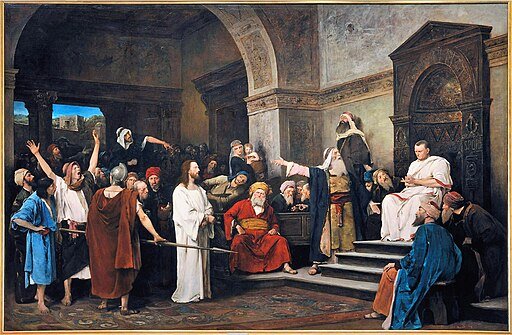The Passion of Christ in Matthew: Meaning, Timeline, and Theological Significance
What is the Passion of Christ?
The Passion of Christ in the Gospel of Matthew (chapters 26–27) refers to the suffering, crucifixion, and death of Jesus. Matthew emphasizes Jesus’ role as the obedient Son, the fulfillment of prophecy, and the Suffering Servant. His Gospel includes the betrayal, Last Supper, trials before Jewish and Roman authorities, the crucifixion, and burial. Matthew also uniquely highlights cosmic signs at Jesus’ death, the tearing of the temple veil, and the guarding of the tomb.
The passion, the suffering of Jesus, works in our imaginations over and again.
Introduction
When we speak of the “Passion of Christ,” we are referring to the final period of Jesus’ earthly life—his arrest, trial, suffering, and crucifixion.
The term “passion” comes from the Latin passio, meaning “suffering.” While all four Gospels recount the Passion, Matthew’s version is rich in Old Testament fulfillment, dramatic irony, and theological depth.
For Matthew, the Passion is not a tragic accident but the climactic moment of divine purpose and prophetic fulfillment.
Overview: The Passion Narrative in Matthew (Chapters 26–27)
Matthew’s Passion narrative begins with the plot to arrest Jesus and ends with his burial in a sealed tomb. Here’s a brief outline:
The Anointing at Bethany (26:6–13)
Judas Agrees to Betray Jesus (26:14–16)
The Last Supper and Institution of the Eucharist (26:17–30)
Gethsemane and Jesus’ Arrest (26:36–56)
Jesus Before the Sanhedrin (26:57–68)
Peter’s Denial (26:69–75)
Jesus Before Pilate (27:1–26)
The Crucifixion (27:27–56)
Jesus’ Death and Burial (27:57–66)
Matthew’s Gospel presents these events with intentional echoes of Jewish history, especially the Exodus and the Suffering Servant in Isaiah 53.
Key Themes in Matthew’s Passion Narrative
1. Jesus as the New Moses and the Fulfillment of the Scriptures
Matthew frequently draws parallels between Jesus and Moses. Just as Moses led a covenant people through suffering into deliverance, Jesus leads a new covenant community through his own suffering and death.
Matthew emphasizes that the events of the Passion happen “to fulfill the Scriptures” (see Matthew 26:54, 26:56, 27:9). These fulfillments include:
Zechariah 11:13 (the thirty pieces of silver),
Isaiah 53 (the suffering and silence of Jesus),
Psalm 22 (the cry of dereliction: “My God, my God, why have you forsaken me?”).
2. The Obedient Son of God
Jesus willingly embraces the cross. His prayer in Gethsemane—“not what I want but what you want” (Matthew 26:39)—reveals his perfect obedience, contrasting with Adam’s disobedience in the Garden of Eden
3. The Role of the Crowd and the Innocence of Jesus
Matthew alone records Pilate’s wife’s dream warning against condemning Jesus (27:19), as well as Pilate washing his hands (27:24)—emphasizing Jesus’ innocence. The crowd’s cry, “His blood be on us and on our children!” (27:25), is both tragic and ironic—pointing ahead to the atoning power of that blood for all who believe.
4. Supernatural Signs and the Temple Veil
Unique to Matthew are the earthquake and the resurrection of saints following Jesus’ death (27:51–53). The tearing of the temple curtain signals the end of the old covenant system and direct access to God through Christ.
Christ in Front of Pilate by Munkacsy.
Theological Significance of the Passion of Christ
Matthew’s Passion is not just history—it’s theology in motion. Jesus dies not merely as a martyr, but as a ransom for many (see Matthew 20:28).
The cross is God’s answer to sin and suffering. It’s where divine justice and mercy meet.
In Matthew, we see:
The sovereignty of God—even betrayal and injustice serve God’s redemptive plan.
The depth of human sin—from Judas’s betrayal to Peter’s denial, to Pilate’s cowardice.
The triumph of grace—a Roman centurion declares, “Truly this man was God’s Son” (27:54), marking the beginning of the Gospel’s reach to the Gentiles.
Meaning for Today: The Passion as the Heart of the Gospel
The Passion of Christ in Matthew invites reflection on our own response to Jesus. Do we stand with the fearful disciples, the mocking crowd, or the faithful women who watched from a distance? Do we confess, like the centurion, that Jesus is truly the Son of God?
The cross is not the end of the story, but it is the center of the Gospel. In it, we see both the horror of sin and the hope of salvation. Matthew calls us not only to believe in what Jesus did, but to take up our own cross and follow Him (Matthew 16:24).
FAQs
What is the Passion of Christ in Matthew?
It refers to Jesus’ suffering and crucifixion, recorded in Matthew 26–27. It highlights His obedience, fulfillment of prophecy, and role as Savior.
Where in Matthew is the crucifixion of Jesus?
Matthew 27:27–56 records the crucifixion, including the mocking, the darkness, Jesus’ death, and signs like the temple veil tearing.
Why is Matthew’s Passion narrative unique?
Matthew includes specific Old Testament fulfillments, cosmic signs, and the resurrection of saints, emphasizing Jesus as the Messiah.
What does the tearing of the temple curtain mean?
It symbolizes that access to God is no longer restricted to temple rituals. Through Christ’s death, we are invited into God’s presence directly.

